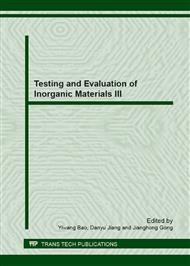p.101
p.105
p.110
p.115
p.120
p.124
p.128
p.135
p.139
Preparation and Properties of Bacteriostatic Sponge
Abstract:
In this paperthe silver particle was adhered to the sponge by different ways and the sponge became to resistance bacterium. The AgNO3 reduced by SnCl2 is the best way via testing the weight gain rate and the antibacterial effect. By comparing the weight gain rate and the antibacterial effect at different concentration, it was found that, when the sponge was soaked in SnCl2 solution at a concentration of 0.10mol/L and AgNO3 solution at a concentration of 1.00mol/L, the sponge prepared by this method had the best antibacterial effect of 99.9%, in which adhered silver particle had uniform distribution and are difficult to fall off.
Info:
Periodical:
Pages:
120-123
Citation:
Online since:
March 2013
Authors:
Keywords:
Price:
Сopyright:
© 2013 Trans Tech Publications Ltd. All Rights Reserved
Share:
Citation:


